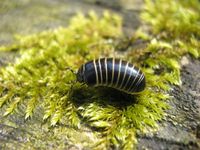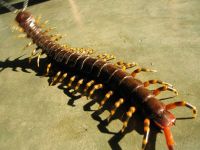User:The dark lord trombonator/Article
It's been far too long since I bothered everybody with a creepy Bug-type. Today, I'm going to talk about Generation V's Venipede, Whirlipede and Scolipede, and hopefully set that right.
Centipedes and millipedes are misunderstood creatures, and I think the first problem is right there in their names. They come from the Latin for "one hundred feet" and "one thousand feet" respectively, but as you may well be aware, this is misleading. The number of legs on a centipede can be anything between thirty and over three hundred, while for millipedes the number varies between thirty six and seven hundred and fifty. So while it’s true that, on average, millipede species have more legs than centipede species, we can see that this isn’t always the case.
So what are the differences between centipedes and millipedes? First, let’s look at what they have in common. Both are classes belonging to the arthropods, a phylum which also contains insects, arachnids and crustaceans, as well as extinct creatures like trilobites. All arthropods have hard exoskeletons, segmented bodies and jointed legs. Most breathe using spiracles: multiple holes in the exoskeleton connected to internal channels that direct oxygen straight into the body's tissues.
While all arthropods have bodies that are divided into segments, centipedes and millipedes take this to the extreme, having extremely long bodies built from mostly-identical segments. Despite these similarities, though, there are some clear differences, and there are numerous ways to tell if you have a centipede or a millipede in your midst.
Firstly, centipedes are fast, while millipedes are slow. This is due to their differing lifestyles: centipedes are predators, which have to be quick in order to catch their prey. Millipedes, however, are detritivores, their diet consisting of decaying leaves and plant matter. Because of this, they don't need to be as agile as their centipede cousins, and are mostly slow-moving creatures.
The other way to tell a millipede from a centipede is to look at their body segments. Millipedes have two pairs of legs per body segment, while centipedes have just one pair. Centipedes are also venomous: their first two legs are adapted into poison-injecting claws called forcipules. Some larger centipede species can even deliver a very painful bite to humans, though such a bite is rarely ever fatal. By contrast, millipedes are relatively harmless. Many millipede species can secrete a poisonous substance from their exoskeleton, but this is designed as a defense mechanism against insects, and poses little threat to us bigger animals. In fact, Capuchin monkeys have been known to deliberately irritate millipedes and then rub the poison they produce onto their skin to repel mosquitoes.
A final feature that's only common to some species of centipede is that the back two legs will be angled backwards, pointing up in the air. This gives the appearance of a second pair of antennae at the animal's rear... and, in fact, that's exactly what these specialized legs function as.
If we look at these descriptions and then compare them to Venipede, Whirlipede and Scolipede, it's apparent that these Pokémon have a lot more in common with centipedes than they do with millipedes. They're all venomous and described as being aggressive. All three also have the rear antennae found on some centipedes (it’s hard to tell where Whirlipede begins and ends, but since it has two sets of antennae, we can assume that one is supposed to be at the front, and the other at the rear). Scolipede's Pokédex entry also mentions venom-injecting front claws: the forcipules mentioned earlier. Based on these features alone, we might conclude that this family of Pokémon is based exclusively on centipedes.
There's a little more to it than that, though, and our first clue comes from Whirlipede's curious design. The ability to curl up into a ball isn't something that's seen amongst centipedes: perhaps not surprising, since it's a defensive action, and centipedes are much more adapted for attack than defense. It is something that we can observe in the meeker millipedes, though. Two orders of millipedes, Glomerida and Sphaerotheriida, have evolved this ability, and are collectively known as pill millipedes due to their resemblance to the pill bug (also known as the woodlouse, a favorite creature of mine and one that sorely needs turning into a Pokémon). Glomerida are found mainly in the Northern Hemisphere and are quite small, making them easily mistaken for pill bugs. Spaerotheriida can get quite a bit larger, and are found in the Southern Hemisphere.
If you thought that Venipede was a little bit short and stubby for a centipede or millipede, then you need look no further than the pill millipedes to see where its design most likely came from. Though we associate centipedes and millipedes (and millipedes especially) with being very long creatures, some of the commonest are quite short. While they undeniably possess many features unique to centipedes, Venipede and Whirlipede seem equally (if not more) inspired by pill millipedes.
But while Venipede and Whirlipede seem to have diverse origins, Scolipede is much closer to being a pure centipede. Its name in both English and Japanese even hints at a specific centipede genus: Scolopendra (Scolipede's Japanese name is Pendror or ペンドラー). It seems likely that there was a particular species they had in mind, too.
Scolopendra gigantea, the Amazonian giant centipede, can reach thirteen inches in length and is generally agreed to be the largest living species of centipede. It lives in South America and the Caribbean, and is an astonishingly quick and efficient predator, preying on the likes of tarantulas, frogs, birds and bats. Scolipede's interesting posture is a reference to the predatory habits of these animals. When hunting, they will anchor themselves with their powerful back legs, and extend their front section upwards, allowing them to reach out and grab unsuspecting prey. They can also do this while dangling from above, which allows them to catch bats in mid-flight.
If this wasn’t horrifying enough, I should point out that there's something even bigger that probably influenced Scolipede's design. Remember how I said that S. gigantea was the largest living species of centipede?
There was once a creature called Arthropleura, a relative of both centipedes and millipedes. It was probably the largest invertebrate ever to live on land, reaching up to two and a half meters in length (which fits in surprisingly well with Scolipede's stated length of 2.5 m). It lived between 340 and 280 million years ago, and its fossils have been found in both North America and Scotland. Fossilized tracks seem to indicate that it could move around very quickly on its thirty pairs of legs. What it ate is still a matter of debate, though it's been speculated to have had a set of very powerful jaws.
Nowadays, arthropods in general are much smaller, due mostly to how they breathe (higher oxygen levels in the past allowed them to grow bigger, but the lower concentration of oxygen in today's atmosphere would be insufficient to support Arthropleura's huge body). But I'd say that what present-day centipedes and millipedes lack in size, they make up for in ingenuity. Whether it's the cautious defensive strategies of the millipede or the all-out attacking fury of the centipede, these are two classes of creature that are very welcome additions to the Pokémon menagerie.



